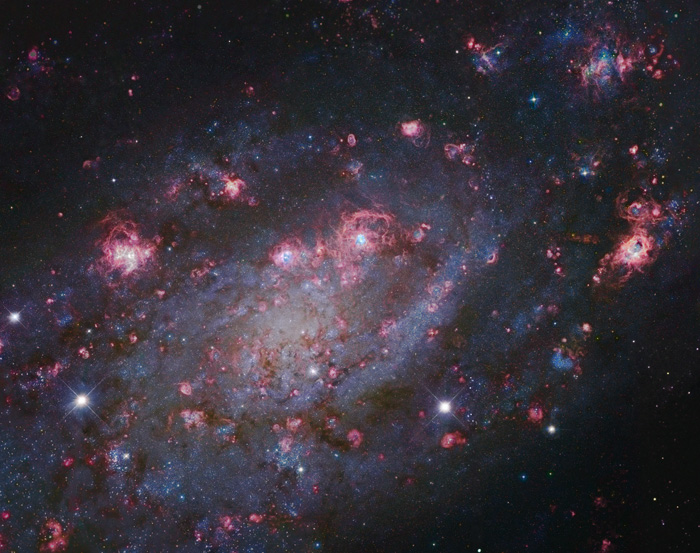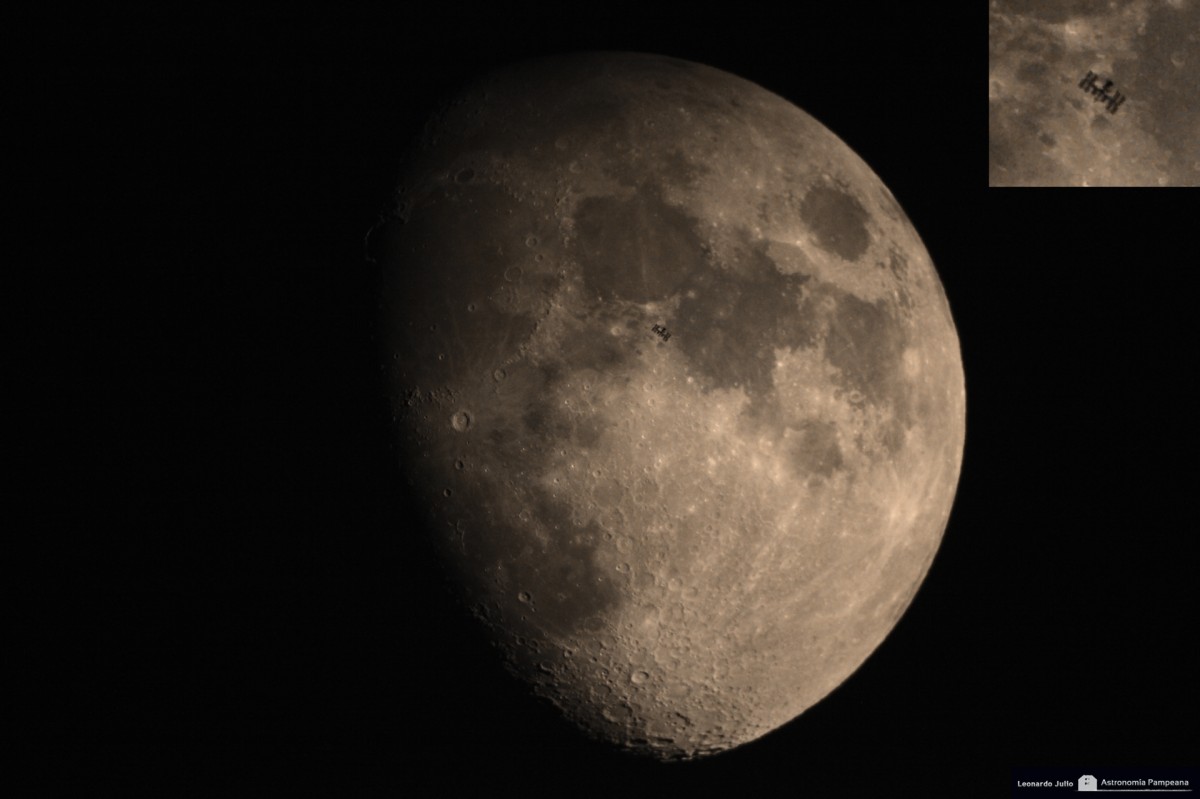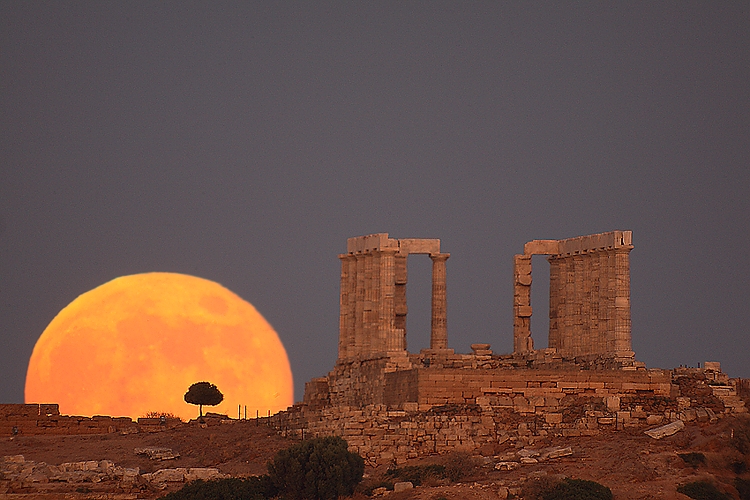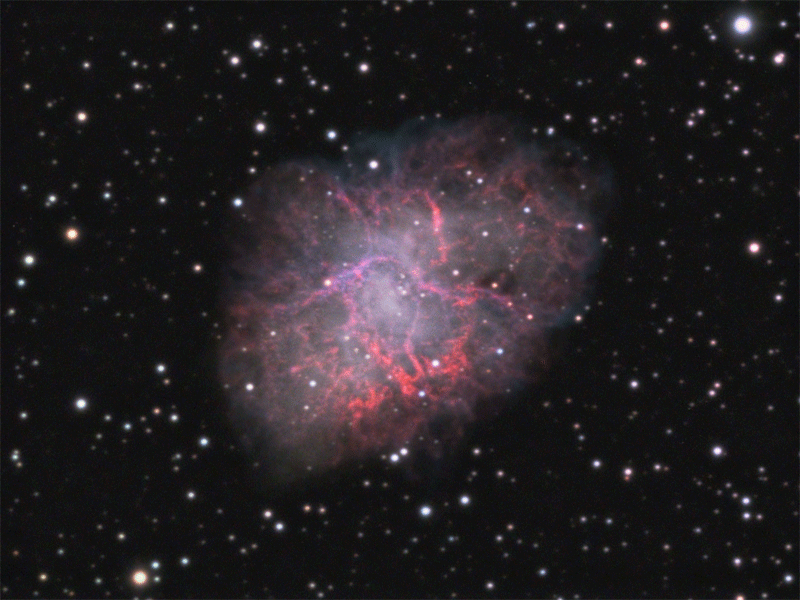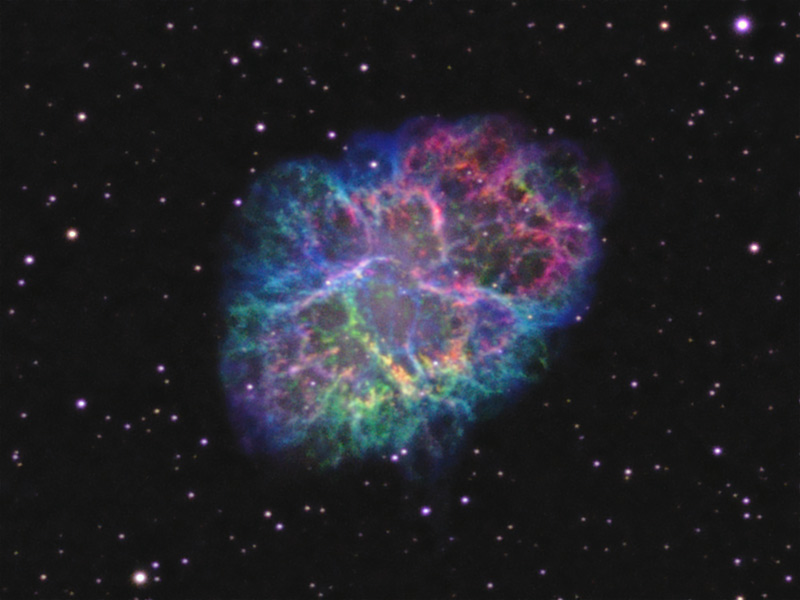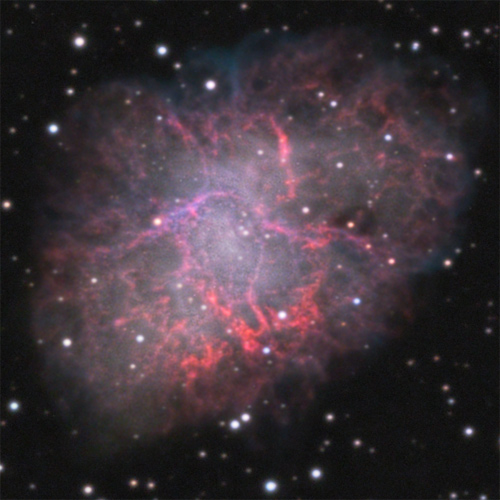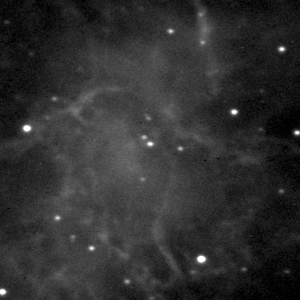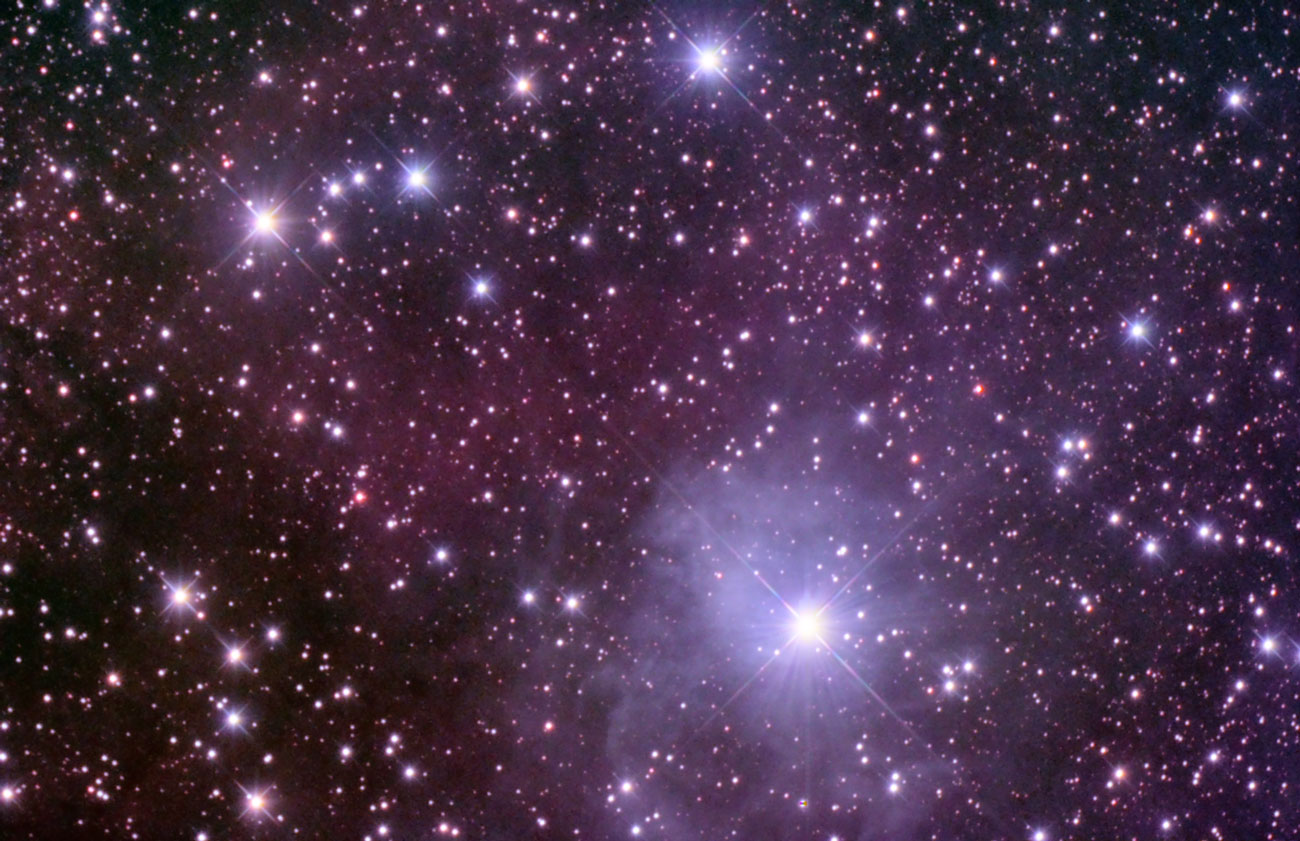Recent Submissions: 2011 July 15-21
Recent Submissions: 2011 July 15-21
________________________________________________________________________________________
Please post your images here.
Please see this thread before posting images; posting images demonstrates your
agreement with the possible uses for your image.
Please keep images under 400K, whether hotlinked or uploaded.
Thank you!
_______________________________________________________________________________________
<- Previous submissions
Please post your images here.
Please see this thread before posting images; posting images demonstrates your
agreement with the possible uses for your image.
Please keep images under 400K, whether hotlinked or uploaded.
Thank you!
_______________________________________________________________________________________
<- Previous submissions
A closed mouth gathers no foot.
Re: Recent Submissions
Last Night's Full Moon
http://www.galacticimages.com
Copyright: John Chumack
[attachment=11]FullMoon071511_ChumackHRweb.jpg[/attachment]
NGC 2403: Spiral Galaxy in Camelopardalis
http://www.robgendlerastropics.com/NGC2 ... u-HST.html
Credit and copyright: Subaru Telescope, National Astronomical Observatory of Japan (NAOJ), Hubble Legacy Archive (data), Robert Gendler (composite image) June's Total Eclipse
http://www.rodsky.com
Copyright: Brice Allenbrand
[attachment=10]Eclipse Totale de Lune - Chapelet portrait.jpg[/attachment]
STS-135
http://www.launchphotography.com/STS-135.html
Copyright: Ben Cooper/LaunchPhotography.com
~ Ben Cooper Halo Display over Eldorado
https://picasaweb.google.com/parkermont ... 6605003266
Copyright: Parker Montgomery
[attachment=7]eldorado.jpg[/attachment]
1876 Charcoal Kilns under the Milky Way
Copyright: Tom McEwan
[attachment=6]Night_Sky_Over_the_Ward_Charcoal_Kilns_by McEwan.jpg[/attachment]
ISS Atlantis Crossing the Sun
http://www.flickr.com/photos/danicaxete/
Copyright: Dani Caxete
[attachment=5]ISS atlantis recorte 14-7-2011.jpg[/attachment]
NGC 6960: The Witch's Broom Nebula in the Veil
Copyright: Lóránd Fényes
[attachment=4]0WEBRE (0000).jpg[/attachment]
Widefield Image of IC 1396
http://imagingtheheavens.com/
Copyright: Michael Sherick
[attachment=3]ic1396-RGB-7-9-11c.jpg[/attachment]
NGC 6888 Narrowband Color
http://www.starimager.com/Image%20Galle ... _1250.html
Copyright: Dave Jurasevich
[attachment=2]ngc6888.jpg[/attachment]
Noctilucent Clouds
http://www.northwest-landscapes.com/ima ... s_0082.jpg
Copyright: Wade Earle
[attachment=1]nlc_wade.jpg[/attachment]
Milky Way over Peace Park
http://www.AstroPics.com
Copyright: Wally Pacholka
[attachment=0]WatertonNatPark-ShoreView-MilkyWay-2144-850wp.jpg[/attachment]
http://www.galacticimages.com
Copyright: John Chumack
[attachment=11]FullMoon071511_ChumackHRweb.jpg[/attachment]
NGC 2403: Spiral Galaxy in Camelopardalis
http://www.robgendlerastropics.com/NGC2 ... u-HST.html
Credit and copyright: Subaru Telescope, National Astronomical Observatory of Japan (NAOJ), Hubble Legacy Archive (data), Robert Gendler (composite image) June's Total Eclipse
http://www.rodsky.com
Copyright: Brice Allenbrand
[attachment=10]Eclipse Totale de Lune - Chapelet portrait.jpg[/attachment]
STS-135
http://www.launchphotography.com/STS-135.html
Copyright: Ben Cooper/LaunchPhotography.com
[attachment=9]premeltdown.jpg[/attachment]
[attachment=8]Meltdown.jpg[/attachment]
This fisheye was perhaps too close. Placed about 250 feet from the right-hand Solid Rocket Booster (much closer than it appears...see other photo), the 180-degree view was both waterlogged and smoked-out, prohibiting a great shot. The lens is likely not reusable (and the plastic protecting the camera melted...).~ Ben Cooper Halo Display over Eldorado
https://picasaweb.google.com/parkermont ... 6605003266
Copyright: Parker Montgomery
[attachment=7]eldorado.jpg[/attachment]
1876 Charcoal Kilns under the Milky Way
Copyright: Tom McEwan
[attachment=6]Night_Sky_Over_the_Ward_Charcoal_Kilns_by McEwan.jpg[/attachment]
ISS Atlantis Crossing the Sun
http://www.flickr.com/photos/danicaxete/
Copyright: Dani Caxete
[attachment=5]ISS atlantis recorte 14-7-2011.jpg[/attachment]
NGC 6960: The Witch's Broom Nebula in the Veil
Copyright: Lóránd Fényes
[attachment=4]0WEBRE (0000).jpg[/attachment]
Widefield Image of IC 1396
http://imagingtheheavens.com/
Copyright: Michael Sherick
[attachment=3]ic1396-RGB-7-9-11c.jpg[/attachment]
NGC 6888 Narrowband Color
http://www.starimager.com/Image%20Galle ... _1250.html
Copyright: Dave Jurasevich
[attachment=2]ngc6888.jpg[/attachment]
Noctilucent Clouds
http://www.northwest-landscapes.com/ima ... s_0082.jpg
Copyright: Wade Earle
[attachment=1]nlc_wade.jpg[/attachment]
Milky Way over Peace Park
http://www.AstroPics.com
Copyright: Wally Pacholka
[attachment=0]WatertonNatPark-ShoreView-MilkyWay-2144-850wp.jpg[/attachment]
- Attachments
A closed mouth gathers no foot.
Re: Recent Submissions
I love the 1876 Charcoal kilns under the Milky Way image. What a juxtapostion of cosmic majesty with the products of an intelligent and technological civilization on a non-interstellar communication level!
Imagine, 1876. Back then, it was known that the stars were far away, and the first star to have its parallax measured, 61 Cygni, had been shown by Friedrich Wilhelm Bessel to have a parallax already back in 1838.

Friedrich Wilhelm Bessel.
On the other hand, it was a complete mystery what made the stars shine - one belief, generally abandoned in 1876 but not really replaced with any other hypothesis, was that the stars shone by burning coal.

Who shovelled coal into the Sun to make it shine? If coal had been the energy source of the Sun, our star would have used up its energy source in 6300 years! See http://www.ucolick.org/~bolte/AY4_00/we ... nergy.html
Let's return to 1876. Back then, nobody had yet seen this famous engraving:
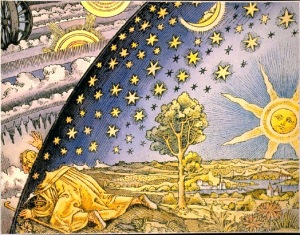
That famous engraving was first published in Camille Flammarion's L’Atmosphère: Météorologie Populaire (Paris, 1888).
But as early as 1686, Bernard Le Bovier de Fontenelle, a French astronomer, wrote his book, Entretiens sur la Pluralité des Mondes (Conversations on the Plurality of Worlds), where he argued that the Moon was an inhabited world, full of life and hardly different at all from the Earth:
Let's return to the technology of 1876. The Otto/Langen atmospheric engine existed - in fact, it was constructed in 1876:
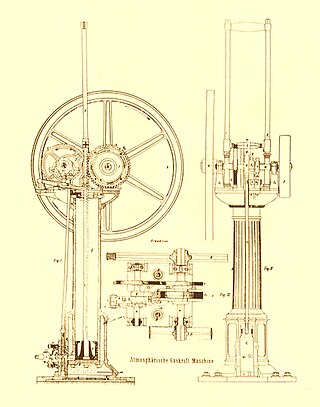
But the four-stroke engine-powered car did not yet exist in 1876:

1876. What a year that was. And the Milky Way shone so brightly in the dark, dark non-light polluted sky, above the charcoal kilns. And the passenger pigeon was not yet extinct.
Ann
Imagine, 1876. Back then, it was known that the stars were far away, and the first star to have its parallax measured, 61 Cygni, had been shown by Friedrich Wilhelm Bessel to have a parallax already back in 1838.

Friedrich Wilhelm Bessel.
On the other hand, it was a complete mystery what made the stars shine - one belief, generally abandoned in 1876 but not really replaced with any other hypothesis, was that the stars shone by burning coal.

Who shovelled coal into the Sun to make it shine? If coal had been the energy source of the Sun, our star would have used up its energy source in 6300 years! See http://www.ucolick.org/~bolte/AY4_00/we ... nergy.html
Let's return to 1876. Back then, nobody had yet seen this famous engraving:

That famous engraving was first published in Camille Flammarion's L’Atmosphère: Météorologie Populaire (Paris, 1888).
But as early as 1686, Bernard Le Bovier de Fontenelle, a French astronomer, wrote his book, Entretiens sur la Pluralité des Mondes (Conversations on the Plurality of Worlds), where he argued that the Moon was an inhabited world, full of life and hardly different at all from the Earth:
Fontenelle meditating on the plurality of worlds, painting from 1791.What accounts do you receive? enquired she. Those, I replied, that are given us by the learned who travel there every day by assistance of telescopes. They tell us they have discovered in the moon, earth, seas, lakes, elevated mountains, and profound abysses.
Let's return to the technology of 1876. The Otto/Langen atmospheric engine existed - in fact, it was constructed in 1876:

But the four-stroke engine-powered car did not yet exist in 1876:

1876. What a year that was. And the Milky Way shone so brightly in the dark, dark non-light polluted sky, above the charcoal kilns. And the passenger pigeon was not yet extinct.
Ann
Color Commentator
-
Efrain Morales
- Science Officer
- Posts: 494
- Joined: Fri Oct 22, 2010 8:15 pm
- AKA: Jaicoa
- Location: Aguadilla, Puerto Rico
- Contact:
Saturn, July 11th
Saturn is becoming difficult to image at this stage (lower altitude, Sunlight). The storm is still active and impressive still its trails seems to be wideing to the north polar region.
Re: Recent Submissions
NGC 5146: The Cocoon Nebula Complex
http://www.galacticimages.com
Copyright: John Chumack
[attachment=5]Cocoon_Nebula_ChumackHRweb.jpg[/attachment]
Solar Transit of the ISS and Atlantis
http://ceastronomy.org/tramakers
Copyright: Theo Ramakers
[attachment=4]SUN-Ha-I-050-222-405-Com2 11-07-14 09-22-33CrpTxtA.jpg[/attachment]
Liftoff from ~10.5 Miles Away
http://www.pbase.com/maxmsm/image/136375275
Copyright: Max S. Mirot
[attachment=3]135liftoff.jpg[/attachment]
Polar Ring Galaxies
http://arxiv.org/abs/1107.1966
Copyright: Alexei Moiseev, Ksenia Smirnova, Aleksandrina Smirnova, Vladimir Reshetnikov
[attachment=2]moiseev_1.jpg[/attachment]
Noctilucent Clouds over Germany
http://www.sternwarte-nms.de
Copyright: Marco Ludwig
[attachment=1]NLWNeumünster12Juli2011MarcoLudwig.jpg[/attachment]
Cederblad 214: Nebula in Cepheus
http://www.astroconti.com
Copyright: Stefano Conti
[attachment=0]Cederblad-214-LRGB-rid_ColorBalance.jpg[/attachment]
http://www.galacticimages.com
Copyright: John Chumack
[attachment=5]Cocoon_Nebula_ChumackHRweb.jpg[/attachment]
Solar Transit of the ISS and Atlantis
http://ceastronomy.org/tramakers
Copyright: Theo Ramakers
[attachment=4]SUN-Ha-I-050-222-405-Com2 11-07-14 09-22-33CrpTxtA.jpg[/attachment]
Liftoff from ~10.5 Miles Away
http://www.pbase.com/maxmsm/image/136375275
Copyright: Max S. Mirot
[attachment=3]135liftoff.jpg[/attachment]
Polar Ring Galaxies
http://arxiv.org/abs/1107.1966
Copyright: Alexei Moiseev, Ksenia Smirnova, Aleksandrina Smirnova, Vladimir Reshetnikov
[attachment=2]moiseev_1.jpg[/attachment]
Noctilucent Clouds over Germany
http://www.sternwarte-nms.de
Copyright: Marco Ludwig
[attachment=1]NLWNeumünster12Juli2011MarcoLudwig.jpg[/attachment]
Cederblad 214: Nebula in Cepheus
http://www.astroconti.com
Copyright: Stefano Conti
[attachment=0]Cederblad-214-LRGB-rid_ColorBalance.jpg[/attachment]
- Attachments
A closed mouth gathers no foot.
Re: Recent Submissions
Atlantis Across the Sun
Copyright: Iris Fernández García (who is five years old)
[attachment=4]Atlantis Sun.jpg[/attachment]
IC4603 and IC4604: Reflection Nebulae in Ophiuchus
http://www.galaxyphoto.de/ic4603ic4604_I.htm
Copyright: Michael Deger Atlantis Launch Plume and Shadow
Copyright: Christopher Reynolds
~ Christopher Reynolds R Corona Australis Nebulae and Cluster
Copyright: Kfir Simon
[attachment=1]corona 7.jpg[/attachment]
Look there! Iridium flare!
http://www.facebook.com/photo.php?fbid= ... =1&theater
Copyright: Hung-Hsuan Yen
[attachment=0]flare.jpg[/attachment]
Last Transit of the ISS and Atlantis over the Moon
http://astronomiapampeana.com.ar/foto/7 ... -Moon.html
Copyright: Leonardo Julio
Copyright: Iris Fernández García (who is five years old)
[attachment=4]Atlantis Sun.jpg[/attachment]
IC4603 and IC4604: Reflection Nebulae in Ophiuchus
http://www.galaxyphoto.de/ic4603ic4604_I.htm
Copyright: Michael Deger Atlantis Launch Plume and Shadow
Copyright: Christopher Reynolds
[attachment=2]IMG_2380.jpg[/attachment]
[attachment=3]IMG_2378.jpg[/attachment]I was at the launch of Atlantis watching from the Banana Creek viewing area, and took these pictures... the first (above) was taken maybe 45-60s after launch, and the second (left) was about 2-3 mins after launch. In addition to the launch plume reaching up to the clouds, you can see the shadow of the continuation of the plume being cast on the top of the clouds (indeed, at the time that the first picture was taken, you could track the flight of the shuttle via the growth of the shadow). ~ Christopher Reynolds R Corona Australis Nebulae and Cluster
Copyright: Kfir Simon
[attachment=1]corona 7.jpg[/attachment]
Look there! Iridium flare!
http://www.facebook.com/photo.php?fbid= ... =1&theater
Copyright: Hung-Hsuan Yen
[attachment=0]flare.jpg[/attachment]
Last Transit of the ISS and Atlantis over the Moon
http://astronomiapampeana.com.ar/foto/7 ... -Moon.html
Copyright: Leonardo Julio
- Attachments
A closed mouth gathers no foot.
Re: Recent Submissions
Selene Rising at Sounion
http://www.perseus.gr/Astro-Lunar-Scenes-Sounion-10.htm
Additional images here, here, and here.
Copyright: Anthony Ayiomamitis Nebular Complex IC1396 in Cepheus
Copyright: Giovanni Sostero and Sara Garzia
[attachment=1]IC1396_Ha-HaGB_2011Jul09.jpg[/attachment]
More IC 1396
Copyright: Daniel Meek
[attachment=0]IC1396.JPG[/attachment]
http://www.perseus.gr/Astro-Lunar-Scenes-Sounion-10.htm
Additional images here, here, and here.
Copyright: Anthony Ayiomamitis Nebular Complex IC1396 in Cepheus
Copyright: Giovanni Sostero and Sara Garzia
[attachment=1]IC1396_Ha-HaGB_2011Jul09.jpg[/attachment]
More IC 1396
Copyright: Daniel Meek
[attachment=0]IC1396.JPG[/attachment]
A closed mouth gathers no foot.
Re: Recent Submissions
Iris, I love your picture of Atlantis across the Sun! 
I love the Selene Rising at Sounion picture, too. Selene, the goddess of the Moon. That tree superimposed on it looks just splendid. Who says there are no trees on the Moon? But that temple was built for Posiedon, the god of the sea. If we consider Poseidon and Neptune to be one and the same, more or less, then perhaps we can say that this is a picture of the Moon rising over a tribute to Neptune?
And speaking about the Moon... the Lady in the Moon just avoided getting the ISS and Atlantis in her eye, eh?
And Max S. Mirot's photo of the lift-oss of Atlantis is fascinating, too. The sailboat and Atlantis... two very different means of human transportation, both requiring technology to construct, but on different levels of sophistication. (And requring very, very different propellants.)
I very much admire Robert Gendler's masterful "combination" of a Subaru and a Hubble Telescope image of NGC 2403.
I love the subtle and beautiful colors of Michael Sherick's RGB image of IC 1396.
And of course, I just love the fascinating "parade" of polar-ring galaxies! Wow! Just look at that amazing variety of these hula-hooping galaxies of the void!
Ann
I love the Selene Rising at Sounion picture, too. Selene, the goddess of the Moon. That tree superimposed on it looks just splendid. Who says there are no trees on the Moon? But that temple was built for Posiedon, the god of the sea. If we consider Poseidon and Neptune to be one and the same, more or less, then perhaps we can say that this is a picture of the Moon rising over a tribute to Neptune?
And speaking about the Moon... the Lady in the Moon just avoided getting the ISS and Atlantis in her eye, eh?
And Max S. Mirot's photo of the lift-oss of Atlantis is fascinating, too. The sailboat and Atlantis... two very different means of human transportation, both requiring technology to construct, but on different levels of sophistication. (And requring very, very different propellants.)
I very much admire Robert Gendler's masterful "combination" of a Subaru and a Hubble Telescope image of NGC 2403.
I love the subtle and beautiful colors of Michael Sherick's RGB image of IC 1396.
And of course, I just love the fascinating "parade" of polar-ring galaxies! Wow! Just look at that amazing variety of these hula-hooping galaxies of the void!
Ann
Color Commentator
Updated version of Pelican Nebula
We wanted to wait for the poll to end before posting an updated version of the Pelican Nebula we made. We think this one is better in color and detail. We hope you agree....
Andre and Daniel
IC5070 Pelican Nebula
http://www.astro-photo.nl
Copyright: André van der Hoeven/Daniel Verloop The full res image can be found here: http://www.astro-photo.nl/images/nebula ... inalv4.jpg
Andre and Daniel
IC5070 Pelican Nebula
http://www.astro-photo.nl
Copyright: André van der Hoeven/Daniel Verloop The full res image can be found here: http://www.astro-photo.nl/images/nebula ... inalv4.jpg
Re: Recent Submissions
Re: Recent Submissions
Thunder Moon from Sounion Cape
http://www.flickr.com/photos/dimitris_kapetanakis/
Copyright: Dimitris Kapetanakis
[attachment=4]img_7033.jpg[/attachment]
Full Moon
Copyright: Ferenc Simics
[attachment=3]100_4318.JPG[/attachment]
Lagoon Nebula
http://astrosurf.com/emilio/
Copyright: Emilio Rivero Padilla
[attachment=2]rgb_4jp.jpg[/attachment]
Lighthouse Moon
Copyright: Larry Landolfi
http://www.flickr.com/photos/dimitris_kapetanakis/
Copyright: Dimitris Kapetanakis
[attachment=4]img_7033.jpg[/attachment]
Full Moon
Copyright: Ferenc Simics
[attachment=3]100_4318.JPG[/attachment]
Lagoon Nebula
http://astrosurf.com/emilio/
Copyright: Emilio Rivero Padilla
[attachment=2]rgb_4jp.jpg[/attachment]
Lighthouse Moon
Copyright: Larry Landolfi
[attachment=1]moonboat.jpg[/attachment]
[attachment=0]moonpaint.jpg[/attachment]- Attachments
A closed mouth gathers no foot.
Re: Recent Submissions
Mmmm, that's a nice Lagoon, Emilio Rivero Padilla. Is it an ordinary RGB image?
And who can resist that "painting" of the rising Moon, Larry Landolfi? Not me!
Ann
And who can resist that "painting" of the rising Moon, Larry Landolfi? Not me!
Ann
Color Commentator
-
bill w
Re: Recent Submissions
Heart of the Crab
In July 1054 AD, astrologers observed a bright blue square in the sky near the sun at dawn. it was visible during the day for 3 weeks and at night for 2 years. 700 years later, the Crab Nebula became the first object in Charles Messier's famous catalog. In the 1940's astronomers calculated the expansion rate of the Crab Nebula and extrapolated back to definitively link the Crab Nebula to the ancient supernova (note motion in the core, more on that later):
as nebulae go, this is an odd one. it looks even more bizarre (and not particularly aesthetically pleasing) in narrow band.
there's just no rhyme or reason to it, a jumble of filaments in primary colors, psychedelic if nothing else:
it doesn't have the typical concentric rings of a supernova remnant:
https://picasaweb.google.com/lh/photo/s ... directlink
nor does it have the typical pillars and ionization fronts seen in emission nebulae:
https://picasaweb.google.com/lh/photo/0 ... directlink
so what's happening?
the bluer of the two central stars is a dense neutron star,
the remnant of the original star compressed so tightly that separate protons and electrons cannot exist
due to the conservation of angular momentum
the tiny neutron star is spinning at 30 cycles per second.
a strong magnetic field associated with the spinning star
accelerates electrons in the surrounding space to relativistic speeds ~half the speed of light!
collisions between the electrons and surrounding gas give off very high energy photons (strong x-ray source).
so what we have are filaments of gas surrounded by high energy photons, rather than a point source illuminating surrounding gas.
here's a closer view, you can see the neutron star (bluish of center pair)
get a sense of swirling whitish blue material around the central star
with red filaments illuminated by the surrounding light: just for fun, i imaged this nebula for 2 months straight to see if i could catch anything moving at relativistic speeds. voila, you can see the motion in the animation (first image). here's a closer greyscale view with a linear stretch (and a bit more noise) for the purists in the crowd:
still more fun:
the crab nebula is 6,000 light years away.
2 good frames taken one month apart show bright wisp motion of 2 pixels in x and y at an image scale of .57 arcsec/px
sin(2.8 px x .57 "/px) x 6000 Ly / (1/12)y = .56 speed of light!
speed of electrons in the crab is quoted as about .5c
QED
OK i'm not really sure the moving wisps represent moving electrons
(love to get an answer),
but it's still pretty cool
but wait...there's more!
it just so happens that i imaged the crab back in 2006
so you can see the larger scale expansion here:
http://whwastro.homestead.com/files/cra ... k-800w.gif
note that the broad band whitish material appears to be expanding faster than the filaments
acceleration from the neutron star?
thanks for reading my post
and your consideration
-bill warden
astro.whwiii.net
In July 1054 AD, astrologers observed a bright blue square in the sky near the sun at dawn. it was visible during the day for 3 weeks and at night for 2 years. 700 years later, the Crab Nebula became the first object in Charles Messier's famous catalog. In the 1940's astronomers calculated the expansion rate of the Crab Nebula and extrapolated back to definitively link the Crab Nebula to the ancient supernova (note motion in the core, more on that later):
as nebulae go, this is an odd one. it looks even more bizarre (and not particularly aesthetically pleasing) in narrow band.
there's just no rhyme or reason to it, a jumble of filaments in primary colors, psychedelic if nothing else:
it doesn't have the typical concentric rings of a supernova remnant:
https://picasaweb.google.com/lh/photo/s ... directlink
nor does it have the typical pillars and ionization fronts seen in emission nebulae:
https://picasaweb.google.com/lh/photo/0 ... directlink
so what's happening?
the bluer of the two central stars is a dense neutron star,
the remnant of the original star compressed so tightly that separate protons and electrons cannot exist
due to the conservation of angular momentum
the tiny neutron star is spinning at 30 cycles per second.
a strong magnetic field associated with the spinning star
accelerates electrons in the surrounding space to relativistic speeds ~half the speed of light!
collisions between the electrons and surrounding gas give off very high energy photons (strong x-ray source).
so what we have are filaments of gas surrounded by high energy photons, rather than a point source illuminating surrounding gas.
here's a closer view, you can see the neutron star (bluish of center pair)
get a sense of swirling whitish blue material around the central star
with red filaments illuminated by the surrounding light: just for fun, i imaged this nebula for 2 months straight to see if i could catch anything moving at relativistic speeds. voila, you can see the motion in the animation (first image). here's a closer greyscale view with a linear stretch (and a bit more noise) for the purists in the crowd:
still more fun:
the crab nebula is 6,000 light years away.
2 good frames taken one month apart show bright wisp motion of 2 pixels in x and y at an image scale of .57 arcsec/px
sin(2.8 px x .57 "/px) x 6000 Ly / (1/12)y = .56 speed of light!
speed of electrons in the crab is quoted as about .5c
QED
OK i'm not really sure the moving wisps represent moving electrons
(love to get an answer),
but it's still pretty cool
but wait...there's more!
it just so happens that i imaged the crab back in 2006
so you can see the larger scale expansion here:
http://whwastro.homestead.com/files/cra ... k-800w.gif
note that the broad band whitish material appears to be expanding faster than the filaments
acceleration from the neutron star?
thanks for reading my post
and your consideration
-bill warden
astro.whwiii.net
Re: Recent Submissions
Bill, I find your images extremely interesting. You deserve a lot more feedback on your images than I am able to give. Why don't you post your image in the "Ask Questions about Astronomy" forum and ask Chris his opinion? Chris Peterson, that is. Chris rarely browses this forum, I think, but he is our foremost expert on astronomical problems. Art, neufer, is also a person you may ask.
Ann
Ann
Color Commentator
Re: Recent Submissions
Bright Lights
Copyright: Bill Metallinos
[attachment=3]galaxy final.jpg[/attachment]
North American and Cocoon Nebulae
downthewormhole.blogspot.com
Copyright: John A Davis
[attachment=2]NA-Mosaic_med.jpg[/attachment]
Sunset over the Aegean
Copyright: Ann Croft
[attachment=1]Aegean sunset.jpg[/attachment]
Stealing a View from Piracy Point
http://www.AstroArn.com
Copyright: Robert Arn
[attachment=0]Stealing a View at Piracy Point.jpg[/attachment]
Copyright: Bill Metallinos
[attachment=3]galaxy final.jpg[/attachment]
North American and Cocoon Nebulae
downthewormhole.blogspot.com
Copyright: John A Davis
[attachment=2]NA-Mosaic_med.jpg[/attachment]
Sunset over the Aegean
Copyright: Ann Croft
[attachment=1]Aegean sunset.jpg[/attachment]
Stealing a View from Piracy Point
http://www.AstroArn.com
Copyright: Robert Arn
[attachment=0]Stealing a View at Piracy Point.jpg[/attachment]
- Attachments
A closed mouth gathers no foot.
Re: Recent Submissions
I really like John A Davis' North America and Cocoon Nebula skyscape. This is a very rich region of the sky, and there are so many things to see here. For those who don't quite recognize the Cocoon Nebula, it is the small round bright pink object at 11 o'clock in the image. Fascinatingly, a long dark dust tail seems to extend from the Cocoon. This is actually a quite common phenomen when it comes to star formation. Many dust clouds are very oblong, and star formation may well start at one end of it. As gas and dust collapse into stars, dust is consumed, and the dark tail seems to disappear to one side of the new stars. But the tail remains on the other side. If the dust is sufficiently thick on the other side, star formation may continue along the remaining dust lane. The effect is somewhat like a long fuse: You've got fireworks in one end of it, and the fireworks progresses - maybe - along the dust lane "fuse":

A similar phenomenon can be seen in this famous region in Corona Australis - note the dark dust tail stretching away to the upper right from the newborn stars: http://apod.nasa.gov/apod/image/0407/ng ... anlbl1.jpg
Note a few other things in John A Davis picture. You should be able to pick out the North America Nebula at about four o'clock, even though there is a lot of red nebulosity stretching away to the right and lower right from it. To the immediate right of the North America Nebula you have the Pelican Nebula. A picture like this one makes it very clear that the North America and the Pelican Nebula are one and the same nebula complex, powered by the same star. The star in question is probably hidden behind the dark dust cloud separating the two nebulae.
As for the red nebula stretching away to the lower right of the North America Nebula, they too appear to belong to the same nebula complex.
Slightly below center in the picture are two big red arcs centered on a blue star in the middle. (The left arc is double.) The acs belong to emission nebula Sharpless 119, and they are powered by the blue star inside. The star is of spectral class O, which is why it is hot enough to power a nebula. The star could be very far away - Hipparcos measured a "false negative" parallax for it - and If it is very far away it must also be extremely bright. The star, 68 Cygni, is a runaway star. You can see that the arc (or arcs) to the left of it is brighter than the arc to the right of it. The star is running away to the lower left in the picture, and that may cause the ionization on the left side of the star to be brighter than to the right side of it.
Here is another picture and some more information about Sharpless 119, the nebula around 68 Cygni: http://www.skyfactory.org/sh2-119/sh2-119.htm.
In the picture that I gave you a link to, you can see a very bright red star to the right of 68 Cygni. That is Xi Cygni, a supergiant star of spectral class K5.
There are very many other things to see and talk about in this fascinating picture, but I'd better stop now before I bore you to death!
Ann

A similar phenomenon can be seen in this famous region in Corona Australis - note the dark dust tail stretching away to the upper right from the newborn stars: http://apod.nasa.gov/apod/image/0407/ng ... anlbl1.jpg
Note a few other things in John A Davis picture. You should be able to pick out the North America Nebula at about four o'clock, even though there is a lot of red nebulosity stretching away to the right and lower right from it. To the immediate right of the North America Nebula you have the Pelican Nebula. A picture like this one makes it very clear that the North America and the Pelican Nebula are one and the same nebula complex, powered by the same star. The star in question is probably hidden behind the dark dust cloud separating the two nebulae.
As for the red nebula stretching away to the lower right of the North America Nebula, they too appear to belong to the same nebula complex.
Slightly below center in the picture are two big red arcs centered on a blue star in the middle. (The left arc is double.) The acs belong to emission nebula Sharpless 119, and they are powered by the blue star inside. The star is of spectral class O, which is why it is hot enough to power a nebula. The star could be very far away - Hipparcos measured a "false negative" parallax for it - and If it is very far away it must also be extremely bright. The star, 68 Cygni, is a runaway star. You can see that the arc (or arcs) to the left of it is brighter than the arc to the right of it. The star is running away to the lower left in the picture, and that may cause the ionization on the left side of the star to be brighter than to the right side of it.
Here is another picture and some more information about Sharpless 119, the nebula around 68 Cygni: http://www.skyfactory.org/sh2-119/sh2-119.htm.
In the picture that I gave you a link to, you can see a very bright red star to the right of 68 Cygni. That is Xi Cygni, a supergiant star of spectral class K5.
There are very many other things to see and talk about in this fascinating picture, but I'd better stop now before I bore you to death!
Ann
Color Commentator
-
Guest
SH2-308
SH2-308
http://www.glitteringlights.com/
Copyright: Marco Lorenzi
HaOIIIRGB composite of a seldom imaged object. On my website visible up to 4000x4000 pixels
http://www.glitteringlights.com/
Copyright: Marco Lorenzi
HaOIIIRGB composite of a seldom imaged object. On my website visible up to 4000x4000 pixels
-
Guest
SH2-308
NGC 6188 and NGC6164
http://www.glitteringlights.com/
Copyright: Marco Lorenzi
HaOIIIRGB composite of a beautiful couple in the sky. On my website visible up to 4000x4000 pixels
http://www.glitteringlights.com/
Copyright: Marco Lorenzi
HaOIIIRGB composite of a beautiful couple in the sky. On my website visible up to 4000x4000 pixels
Re: Recent Submissions
VDB 133 in Cygnus
http://www.rwstanley.com/VDB%20133%202011%20large.htm
Copyright: Ron Stanley Milky Way Shooting Star
http://www.flickr.com/photos/ryantb/5032101739/
Copyright: Ryan Bohner
[attachment=1]5032101739_c16f1a440d_b.jpg[/attachment]
Starry, Moonlit Night Delta Launch
http://www.launchphotography.com/GPS_2F-2.html
Copyright: Ben Cooper/LaunchPhotography.com Cocoon Nebula and Barnard 168 Region in Cygnus
Credit and copyright: Greg Parker, acquisition; Noel Carboni, processing
[attachment=0]Cocoon_APOD.jpg[/attachment]
http://www.rwstanley.com/VDB%20133%202011%20large.htm
Copyright: Ron Stanley Milky Way Shooting Star
http://www.flickr.com/photos/ryantb/5032101739/
Copyright: Ryan Bohner
[attachment=1]5032101739_c16f1a440d_b.jpg[/attachment]
Starry, Moonlit Night Delta Launch
http://www.launchphotography.com/GPS_2F-2.html
Copyright: Ben Cooper/LaunchPhotography.com Cocoon Nebula and Barnard 168 Region in Cygnus
Credit and copyright: Greg Parker, acquisition; Noel Carboni, processing
[attachment=0]Cocoon_APOD.jpg[/attachment]
A closed mouth gathers no foot.
Re: Recent Submissions
Farewell Atlantis
http://www.pbase.com/rolfolsen/astro_photography
Copyright: Rolf Wahl Olsen
[attachment=0]iss.jpg[/attachment]
http://i.pbase.com/g4/03/951103/2/13654 ... ecwzel.jpg
I grabbed this image tonight of ISS and Atlantis on the last ever Shuttle mission STS-135 while they entered the Earth's shadow over the Pacific Ocean at 18:25 NZST.
The ISS and Atlantis undocked from each other just 3 minutes later at 18:28 NZST. This marks the last time that a Space Shuttle docked at the ISS, as well as the last ever Space Shuttle flight of the U.S space program.
During the 5 minute exposure clouds rolled in and obscured parts of the ISS path after the pair had faded from view, but this added a rather nice overall effect to the image I think.
Larger version available here: http://www.pbase.com/rolfolsen/image/136543398
These were the events taking place during and immediately after this exposure, as covered by spaceflightnow.com:
0623 GMT
Five minutes from undocking. The steering jets on Atlantis are inhibited for the period of physical undocking from the station. The separation occurs when large springs push the two craft apart. Once the shuttle is a couple feet away from the station and the docking devices are clear of one another, pilot Doug Hurley will fire Atlantis' thrusters to continue the movement away.
0625 GMT
The spacecraft are nearing an orbital sunset. The undocking will occur in darkness but the later flyaround of the station by Atlantis will take place in daylight.
0626 GMT
Hooks and latches are driving open.
0628 GMT
UNDOCKING! The final space shuttle parts company with the International Space Station, a sentimental sendoff for America's winged machines that spent the past decade constructing the million-pound science complex and supplying the orbiting laboratory with vast loads of logistics. In 37 missions, the shuttles spent 276 days, 11 hours and 23 minutes docked at the station.
With the shuttles entering forced retirement, the space station now must rely upon Russian, European and Japanese unmanned cargo freighters for continued support. U.S. commercial servicing missions by SpaceX and Orbital Sciences are planned to start by next year.
And the Russian Soyuz becomes the sole means of launching astronauts to the station and returning them to Earth. The American effort to develop a new human spacecraft to replace the shuttles remains years from taking flight.
The food and equipment delivered by Atlantis ensures the space station has enough provisions to support a full six-person resident crew for the next year while awaiting the U.S. commercial firms to get the routine resupply missions underway.
0630 GMT
After 8 days, 15 hours and 21 minutes of being linked together high above Earth, shuttle Atlantis undocked from the International Space Station on-time at 2:28 a.m. as the two spacecraft flew 243 miles over the Pacific Ocean, east of New Zealand.
Hope you like it. It was a spectacular sight.
Regards,
Rolf
http://www.pbase.com/rolfolsen/astro_photography
Copyright: Rolf Wahl Olsen
[attachment=0]iss.jpg[/attachment]
http://i.pbase.com/g4/03/951103/2/13654 ... ecwzel.jpg
I grabbed this image tonight of ISS and Atlantis on the last ever Shuttle mission STS-135 while they entered the Earth's shadow over the Pacific Ocean at 18:25 NZST.
The ISS and Atlantis undocked from each other just 3 minutes later at 18:28 NZST. This marks the last time that a Space Shuttle docked at the ISS, as well as the last ever Space Shuttle flight of the U.S space program.
During the 5 minute exposure clouds rolled in and obscured parts of the ISS path after the pair had faded from view, but this added a rather nice overall effect to the image I think.
Larger version available here: http://www.pbase.com/rolfolsen/image/136543398
These were the events taking place during and immediately after this exposure, as covered by spaceflightnow.com:
0623 GMT
Five minutes from undocking. The steering jets on Atlantis are inhibited for the period of physical undocking from the station. The separation occurs when large springs push the two craft apart. Once the shuttle is a couple feet away from the station and the docking devices are clear of one another, pilot Doug Hurley will fire Atlantis' thrusters to continue the movement away.
0625 GMT
The spacecraft are nearing an orbital sunset. The undocking will occur in darkness but the later flyaround of the station by Atlantis will take place in daylight.
0626 GMT
Hooks and latches are driving open.
0628 GMT
UNDOCKING! The final space shuttle parts company with the International Space Station, a sentimental sendoff for America's winged machines that spent the past decade constructing the million-pound science complex and supplying the orbiting laboratory with vast loads of logistics. In 37 missions, the shuttles spent 276 days, 11 hours and 23 minutes docked at the station.
With the shuttles entering forced retirement, the space station now must rely upon Russian, European and Japanese unmanned cargo freighters for continued support. U.S. commercial servicing missions by SpaceX and Orbital Sciences are planned to start by next year.
And the Russian Soyuz becomes the sole means of launching astronauts to the station and returning them to Earth. The American effort to develop a new human spacecraft to replace the shuttles remains years from taking flight.
The food and equipment delivered by Atlantis ensures the space station has enough provisions to support a full six-person resident crew for the next year while awaiting the U.S. commercial firms to get the routine resupply missions underway.
0630 GMT
After 8 days, 15 hours and 21 minutes of being linked together high above Earth, shuttle Atlantis undocked from the International Space Station on-time at 2:28 a.m. as the two spacecraft flew 243 miles over the Pacific Ocean, east of New Zealand.
Hope you like it. It was a spectacular sight.
Regards,
Rolf
Last edited by SkyViking on Tue Aug 30, 2011 3:36 am, edited 2 times in total.
Reason: Attached image, as pbase images don't hotlink well; left original link. Thanks for sharing!
Reason: Attached image, as pbase images don't hotlink well; left original link. Thanks for sharing!
-
Bi2L
- Science Officer
- Posts: 103
- Joined: Tue Jul 19, 2011 11:24 am
- AKA: Bill Metallinos
- Location: Corfu, Greece
- Contact:
Re: Recent Submissions
Hello, sorry quoting my own picture but I found it very smallowlice wrote:Bright Lights
Copyright: Bill Metallinos
[attachment=3]galaxy final.jpg[/attachment]
Here you can find it bigger: Bright Lights
Re: Recent Submissions
Yes, I try to keep posted images (whether attached or hotlinked) under 400K so as not to slow down the forum too much; the display size is determined by the forum software. Thanks for providing a link to the larger image!
A closed mouth gathers no foot.
Re: Recent Submissions
Ann Croft, it's always nice to see a woman post a picture here!  (A woman with my own first name, too.
(A woman with my own first name, too.  )
)
Your picture shows a fascinatingly distorted-looking Sun, almost certainly because of all the thick and unsteady air that the light of the Sun has to pass through before it reaches us when the Sun is near the horizon.
Good shot!
Ann
Your picture shows a fascinatingly distorted-looking Sun, almost certainly because of all the thick and unsteady air that the light of the Sun has to pass through before it reaches us when the Sun is near the horizon.
Good shot!
Ann
Color Commentator
Re: Recent Submissions
Marco Lorenzi, I love your two images. It is so unusual to see RGB photography combined not only with extra Ha exposures, but with extra OIII exposures as well. I'm fascinated by that delicate but huge blue bubble surrounding Wolf-Rayet star EZ Canis Majoris, Sharpless 308. The bubble, accroding to an APOD caption of another picture of Sharlpless 308 (http://apod.nasa.gov/apod/ap090423.html), is 60 light-years across. The nebula is like a scaled-up version of a planetary nebula, and the central Wolf Rayet star is like a scaled-up (more massive and powerful) version of a white dwarf. And fascinatingly, there are red portions of hydrogen emission inside as well as just outside the blue bubble. Just like in so many planetary nebulae, the red and blue parts of the nebula are found in different places.
I'm almost even more fascinated by the even more delicate-looking, gently undulating blue nebula surrounding O-type star HD 148937 and its two bright red "bar ends" of hydrogen nebulosity. This general skyscape is all the more amazing because of the presence of the large and dramatic emission nebula NGC 6188 and small bright cluster NGC 6193, which contains the nearest known star that may belong to super-hot spectral class O3. It's like looking into a cosmic cave, where strange stellar denizens of immense power are dwelling. (Harry Potter, I don't think your magic wand will work here, not even the Elder Wand, if you still had it...)
Amazing photos!
Ann
I'm almost even more fascinated by the even more delicate-looking, gently undulating blue nebula surrounding O-type star HD 148937 and its two bright red "bar ends" of hydrogen nebulosity. This general skyscape is all the more amazing because of the presence of the large and dramatic emission nebula NGC 6188 and small bright cluster NGC 6193, which contains the nearest known star that may belong to super-hot spectral class O3. It's like looking into a cosmic cave, where strange stellar denizens of immense power are dwelling. (Harry Potter, I don't think your magic wand will work here, not even the Elder Wand, if you still had it...)
Amazing photos!
Ann
Color Commentator
